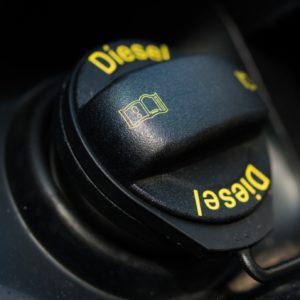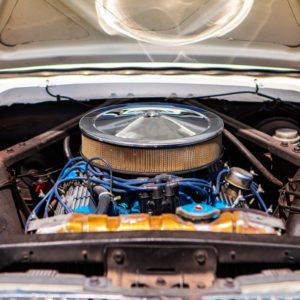Internal combustion gasoline engines run on a mixture of gasoline and air. The ideal mixture is 14.7 parts of air to one part of gasoline (by weight.) Since gas weighs much more than air, we are talking about a whole lot of air and a tiny bit of gas. One part of gas that is completely vaporized into 14.7 parts of air can produce tremendous power when ignited inside an engine.
Let’s see how the modern engine uses that energy to make the wheels turn.
Air enters the engine through the air cleaner and proceeds to the throttle plate. You control the amount of air that passes through the throttle plate and into the engine with the gas pedal. It is then distributed through a series of passages called the intake manifold, to each cylinder. At some point after the air cleaner, depending on the engine, fuel is added to the air-stream by either a fuel injection system or, in older vehicles, by the carburetor.

Once the fuel is vaporized into the air stream, the mixture is drawn into each cylinder as that cylinder begins its intake stroke. When the piston reaches the bottom of the cylinder, the intake valve closes and the piston begins moving up in the cylinder compressing the charge. When the piston reaches the top, the spark plug ignites the fuel-air mixture causing a powerful expansion of the gas, which pushes the piston back down with great force against the crankshaft, just like a bicycle rider pushing against the pedals to make the bike go.
Let’s take a closer look at this process.
Engine Types

The majority of engines in motor vehicles today are four-stroke, spark-ignition internal combustion engines. The exceptions like the diesel and rotary engines will not be covered in this article.
There are several engine types which are identified by the number of cylinders and the way the cylinders are laid out. Motor vehicles will have from 3 to 12 cylinders which are arranged in the engine block in several configurations. The most popular of them are shown on the left. In-line engines have their cylinders arranged in a row. 3, 4, 5 and 6 cylinder engines commonly use this arrangement. The “V” arrangement uses two banks of cylinders side-by-side and is commonly used in V-6, V-8, V-10 and V-12 configurations. Flat engines use two opposing banks of cylinders and are less common than the other two designs. They are used in engines from Subaru and Porsche in 4 and 6 cylinder arrangements as well as in the old VW beetles with 4 cylinders. Flat engines are also used in some Ferraris with 12 cylinders

Most engine blocks are made of cast iron or cast aluminum.
Each cylinder contains a piston that travels up and down inside the cylinder bore. All the pistons in the engine are connected through individual connecting rods to a common crankshaft.

The crankshaft is located below the cylinders on an in-line engine, at the base of the V on a V-type engine and between the cylinder banks on a flat engine. As the pistons move up and down, they turn the crankshaft just like your legs pump up and down to turn the crank that is connected to the pedals of a bicycle.
A cylinder head is bolted to the top of each bank of cylinders to seal the individual cylinders and contain the combustion process that takes place inside the cylinder. Most cylinder heads are made of cast aluminum or cast iron. The cylinder head contains at least one intake valve and one exhaust valve for each cylinder. This allows the air-fuel mixture to enter the cylinder and the burned exhaust gas to exit the cylinder. Engines have at least two valves per cylinder, one intake valve and one exhaust valve. Many newer engines are using multiple intake and exhaust valves per cylinder for increased engine power and efficiency. These engines are sometimes named for the number of valves that they have such as “24 Valve V6” which indicates a V-6 engine with four valves per cylinder. Modern engine designs can use anywhere from 2 to 5 valves per cylinder.


The valves are opened and closed by means of a camshaft. A camshaft is a rotating shaft that has individual lobes for each valve. The lobe is a “bump” on one side of the shaft that pushes against a valve lifter moving it up and down. When the lobe pushes against the lifter, the lifter in turn pushes the valve open. When the lobe rotates away from the lifter, the valve is closed by a spring that is attached to the valve. A common configuration is to have one camshaft located in the engine block with the lifters connecting to the valves through a series of linkages. The camshaft must be synchronized with the crankshaft so that the camshaft makes one revolution for every two revolutions of the crankshaft. In most engines, this is done by a “Timing Chain” (similar to a bicycle chain) that connects the camshaft with the crankshaft. Newer engines have the camshaft located in the cylinder head directly over the valves. This design is more efficient but it is more costly to manufacture and requires multiple camshafts on Flat and V-type engines. It also requires much longer timing chains or timing belts which are prone to wear. Some engines have two camshafts on each head, one for the intake valves and one for the exhaust valves. These engines are called Double Overhead Camshaft (D.O.H.C.) Engines while the other type is called Single Overhead Camshaft (S.O.H.C.) Engines. Engines with the camshaft in the block are called Overhead Valve (O.H.V) Engines.
Now when you see “DOHC 24 Valve V6”, you’ll know what it means.
How an Engine Works

Since the same process occurs in each cylinder, we will take a look at one cylinder to see how the four stroke process works.
The four strokes are Intake, Compression, Power and Exhaust. The piston travels down on the Intake stroke, up on the Compression stroke, down on the Power stroke and up on the Exhaust stroke. Running Engine
Intake
As the piston starts down on the Intake stroke, the intake valve opens and the fuel-air mixture is drawn into the cylinder (similar to drawing back the plunger on a hypodermic needle to allow fluid to be drawn into the chamber.)
When the piston reaches the bottom of the intake stroke, the intake valve closes, trapping the air-fuel mixture in the cylinder.
Compression
The piston moves up and compresses the trapped air fuel mixture that was brought in by the intake stroke. The amount that the mixture is compressed is determined by the compression ratio of the engine. The compression ratio on the average engine is in the range of 8:1 to 10:1.
This means that when the piston reaches the top of the cylinder, the air-fuel mixture is squeezed to about one tenth of its original volume.
Power
The spark plug fires, igniting the compressed air-fuel mixture which produces a powerful expansion of the vapor. The combustion process pushes the piston down the cylinder with great force turning the crankshaft to provide the power to propel the vehicle. Each piston fires at a different time, determined by the engine firing order. By the time the crankshaft completes two revolutions, each cylinder in the engine will have gone through one power stroke.
Exhaust
With the piston at the bottom of the cylinder, the exhaust valve opens to allow the burned exhaust gas to be expelled to the exhaust system. Since the cylinder contains so much pressure, when the valve opens, the gas is expelled with a violent force (that is why a vehicle without a muffler sounds so loud.) The piston travels up to the top of the cylinder pushing all the exhaust out before closing the exhaust valve in preparation for starting the four stroke process over again.
Oiling System
Oil is the life-blood of the engine. An engine running without oil will last about as long as a human without blood. Oil is pumped under pressure to all the moving parts of the engine by an oil pump. The oil pump is mounted at the bottom of the engine in the oil pan and is connected by a gear to either the crankshaft or the camshaft. This way, when the engine is turning, the oil pump is pumping. There is an oil pressure sensor near the oil pump that monitors pressure and sends this information to a warning light or a gauge on the dashboard. When you turn the ignition key on, but before you start the car, the oil light should light, indicating that there is no oil pressure yet, but also letting you know that the warning system is working. As soon as you start cranking the engine to start it, the light should go out indicating that there is oil pressure.
Engine Cooling
Internal combustion engines must maintain a stable operating temperature, not too hot and not too cold. With the massive amounts of heat that is generated from the combustion process, if the engine did not have a method for cooling itself, it would quickly self-destruct. Major engine parts can warp causing oil and water leaks and the oil will boil and become useless.
While some engines are air-cooled, the vast majority of engines are liquid cooled. The water pump circulates coolant throughout the engine, hitting the hot areas around the cylinders and heads and then sends the hot coolant to the radiator to be cooled off. For more information on the cooling system, click here.
Engine Balance
Flywheel – A 4 cylinder engine produces a power stroke every half crankshaft revolution, an 8 cylinder, every quarter revolution. This means that a V8 will be smother running than a 4. To keep the combustion pulses from generating a vibration, a flywheel is attached to the back of the crankshaft. The flywheel is a disk that is about 12 to 15 inches in diameter. On a standard transmission car, the flywheel is a heavy iron disk that doubles as part of the clutch system. On automatic equipped vehicles, the flywheel is a stamped steel plate that mounts the heavy torque converter. The flywheel uses inertia to smooth out the normal engine pulses.
Balance Shaft – Some engines have an inherent rocking motion that produces an annoying vibration while running. To combat this, engineers employ one or more balance shafts. A balance shaft is a heavy shaft that runs through the engine parallel to the crankshaft. This shaft has large weights that, while spinning, offset the rocking motion of the engine by creating an opposite rocking motion of their own.
Get Replacement Engine Parts for Your Vehicle
You might think you’re saving more money by holding off on replacing a bad camshaft or defective intake valve, but that couldn’t be further from the truth. Even if your engine manages to start, driving around with damaged parts is sure to lead to costly engine damage. Luckily, you don’t have to worry about any of that as long as you get replacement parts from CarParts.com today.
Whether you’re in the market for a new camshaft or a replacement flywheel, you’re sure to find what you’re looking for at CarParts.com. We offer a wide selection of camshafts, flywheels, and other engine parts that are sourced from only the most trusted manufacturers in the industry. In other words, you can trust us to give you your money’s worth. CarParts.com also guarantees fast shipping, so you can get back on the road as soon as possible. If you order by 12 p.m. ET, you can even expect your new engine parts to arrive in as fast as two business days.
Don’t wait until your engine completely fails before replacing defective parts. Check out our selection of high-quality camshafts, intake valves, flywheels, and more at CarParts.com and order today.
Any information provided on this Website is for informational purposes only and is not intended to replace consultation with a professional mechanic. The accuracy and timeliness of the information may change from the time of publication.

















Knowing a bout doble Camshaft is very interesting.
Double Overhead Camshaft